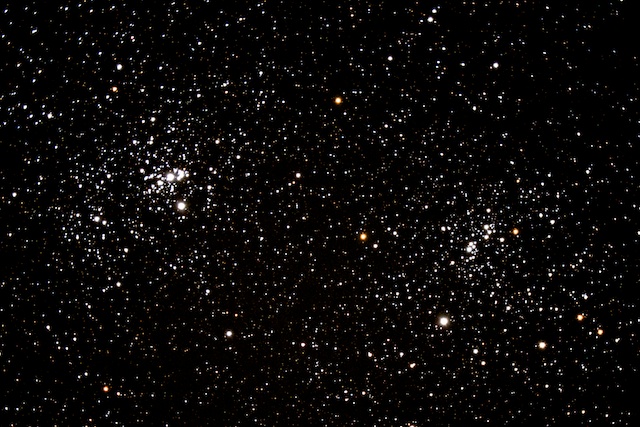
D7000 Limiting Magnitude, iPhone Jupiter
Posted: 17 November 2011
As I walked to the observatory Wednesday evening, 17 November, I could see Venus and Mercury (below Venus), low in the western sky. I grabbed this f/4.8, 1/30sec, ISO 1600, focal length 116mm, photograph:

The observatory was opened at 1809 MST, temperature 61°F. At 1815 MST, viewed Jupiter, low in the eastern sky, at 77X. Seeing was much better this night than on the previous night. Had some good views of Jupiter at 206X with a moon filter attached to the eyepiece. I continued to observe Jupiter until 2010 MST. At 1945 MST, I could just detect the Great Red Spot rotating into view. While waiting for Jupiter to rise higher in the sky and the Great Red Spot to become better visible, I decided to redo a photographic "limiting magnitude" test.
I had last done a limiting magnitude test in October 2008. At that time, I used a 2 minute, ISO 1600, D70 DSLR image of M57 and the Voyager star chart program, to determine that the faintest magnitude imaged was +16.84. This time I used my Nikon D7000 DSLR at prime focus + focal reducer, ISO 6400, to image the Double Cluster. This is a 1 minute, unguided, slightly cropped, image:

And this is a 10 minute, guided, slightly cropped, image, converted to black and white:

I used Voyager 4.5 (Mac OS X) to determine the faintest magnitude on the black and white image. I located a star in the image that was +17.48. That is pretty good for a consumer level DSLR.
I ended D7000 imaging at 2048 MST. The humidity was increasing again, just as on the previous night. Things were getting damp. The humidity was 55%. At 2055 MST, I returned to Jupiter. The Great Red Spot was clearly visible now. I began setting up for iPhone afocal imaging using the MX-1 adapter.
This is a single frame image using the iOS Camera app, afocal 222X, with moon filter, showing three moons (L-R: Io, Europa, and Callisto) and an overexposed Jupiter:

With the moon filter still on the eyepiece, I added the 3X TeleXtender (yielding 666X) and took this single frame image:

The large disturbance in the North Equatorial Belt (NEB) is visible, as is the Great Red Spot (in the South Equatorial Belt, SEB).
I then did some iPhone 4 video recordings at 666X (+ moon filter). I took recordings of 30 seconds, 1, 2, and 5 minutes. During post-processing, I stacked the video frames using Keith's Image Stacker. The 1 minute exposure, consisting of 1465 frames, turned out the best:

The NEB disturbance, the Great Red Spot, and its "baby brother" to the right of the GRS, are visible, as are various shadings in the cloud belts. This is my best Jupiter image to date. But I do need to clean the eyepiece before my next Jupiter imaging session.
2130 MST: went back to visual Jupiter observing. At 222X, the GRS and its baby brother were clearly visible.
Closed the observatory at 2145 MST, 52°F.
My recent "Thoughts on Light Pollution & Light Nuisance" article was published by the Oracle News Email (O.N.E.) newsletter. Thanks Evaline!
Go to the previous report.
Return to the Cassiopeia Observatory Welcome Page.